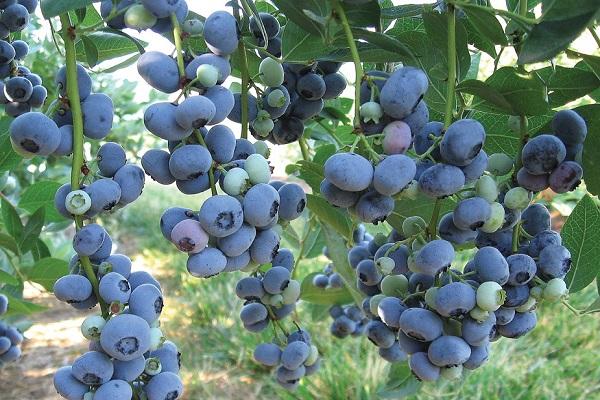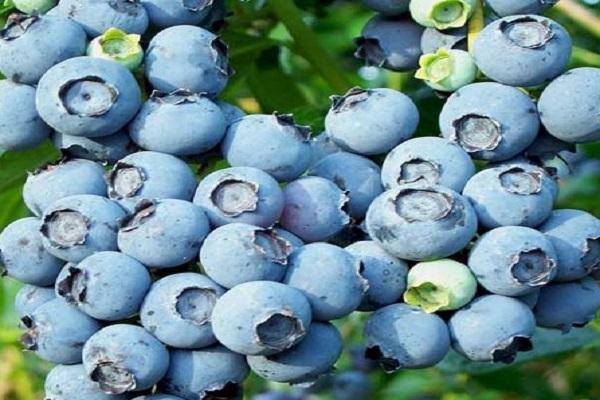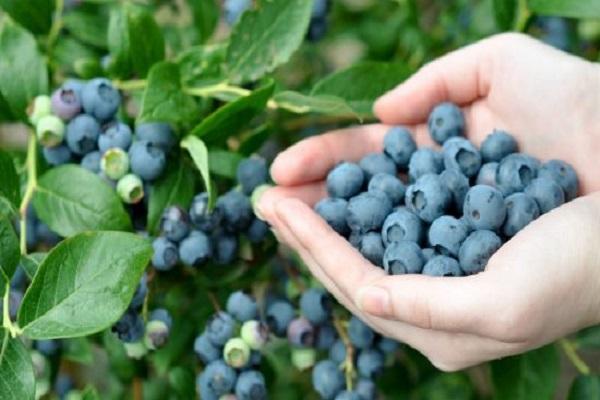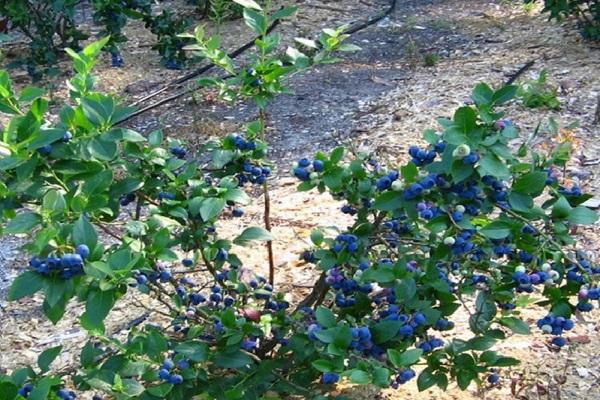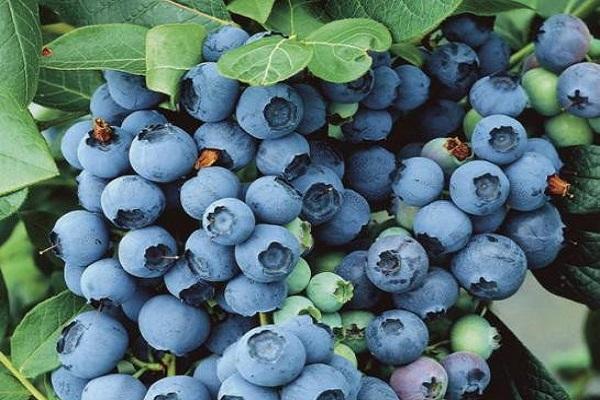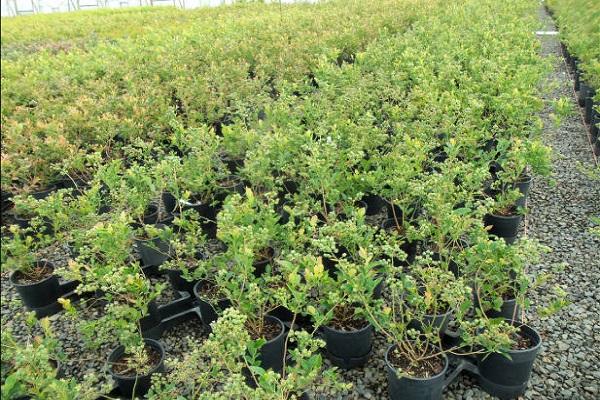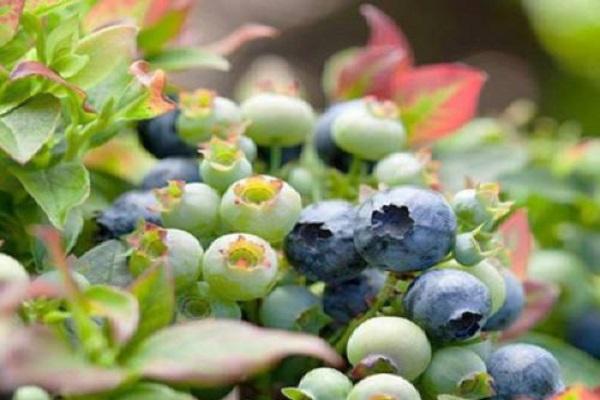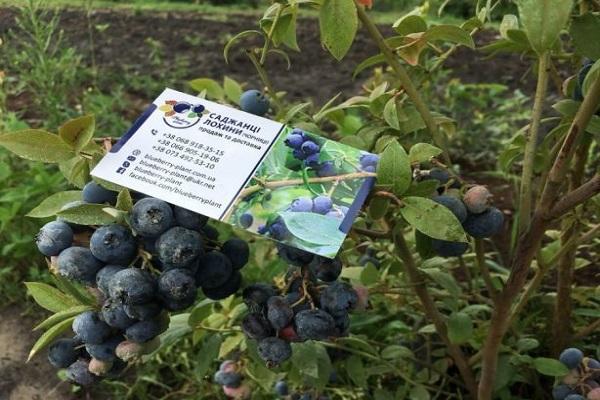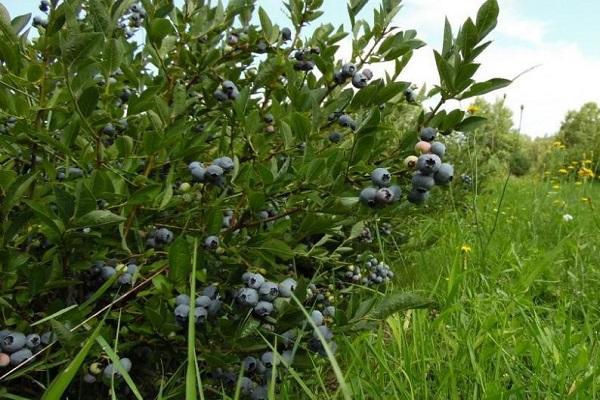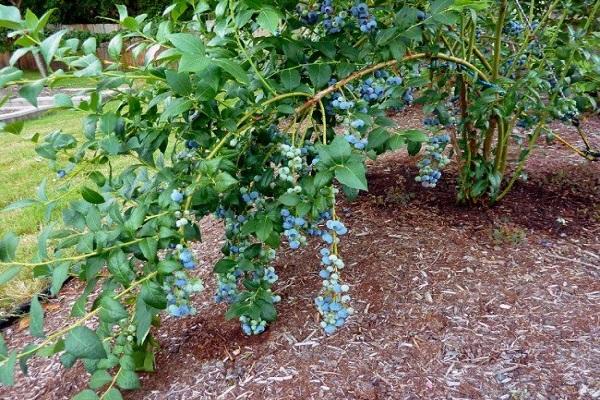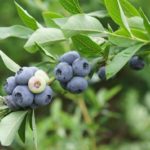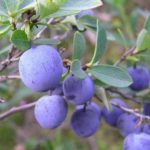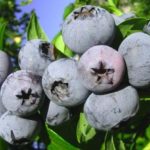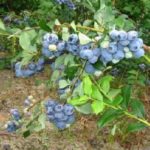Bluegold blueberries are very popular among experienced and novice gardeners. Exotic culture is not only tasty, but also healthy. The plant perfectly decorates the garden and creates a romantic atmosphere. The variety became popular more than 100 years ago in the CIS countries. To successfully grow blueberries, you should familiarize yourself with all their features.
- History of origin
- Main advantages and disadvantages
- Description of berries
- Bush and roots
- Flowering and fruiting
- How to use blueberries
- Susceptibility to diseases and insects of the bush
- Resistance to sub-zero temperatures and drought
- Recommendations for planting crops
- Landing dates
- Selection of berry seedlings
- Preparing the soil and planting hole
- Bush planting technology
- Specifics of caring for berries during the season
- Irrigation and fertilizing
- Weeding and mulching bush beds
- Berry pruning procedure
- Preparing bushes for winter
- Harvest and storage
- Reviews about the variety
History of origin
The tall blueberry bush Blugold was bred in 1989, a variety native to America. The discoverer was A. Draper. When working on the varietal crop, we used tall forms of berries growing in the marshy areas of the USA. Blueberries became immediately popular and gained recognition in America and Europe. By the end of the 1990s, gardeners from the former USSR discovered the variety.
Main advantages and disadvantages
Bush blueberry plantings suggest a number of positive and negative qualities. The negative aspects can be mitigated by following agronomic techniques.
| pros | Minuses |
| Dense, juicy blueberry pulp | Rapid growth of bushes |
| Long-term storage, easy transportability | Berries fall off after ripening |
| High bush yield | In the heat, the fruits bake |
| Self-fertile variety | |
| High resistance of the bush to frost |
Description of berries
Bluegold blueberries differ from other varieties in such features.
- The flavor appears at the same time the berries ripen. The fruits become colored much earlier than ripening. They are easily separated from the fruit stem, and when they ripen, they quickly fall off.
- The berries are light blue in color, round. The size is average, diameter is 15 cm, weight is 2.1 grams. The juice is without a distinct color, the pulp includes many seeds.
- Blueberries have a sweet and sour taste, the sugar content is 9.6%. The variety received a tasting score of 4.3 points.
This variety of berry bushes is worthy of cultivation and does not require painstaking care..
Bush and roots
Blueberry is a perennial deciduous shrub, the rhizome is fibrous and branched. It is located at a depth of 40 cm.
- The bush grows up to 1.2 meters.
- There are many erect shoots.
- The branches are strong, 3 cm in diameter.
- Ellipse-shaped leaves.
The foliage changes color towards the end of August. In September the bushes turn purple.
Flowering and fruiting
Blueberries begin to bloom in the first half of June, pollen continues until the beginning of July, 20 days. The variety bears fruit in early August, but the fruits may ripen earlier or later, depending on the climatic conditions of the region. The plant is considered mid-season and produces fruits after 3 years of life. The largest amount of the crop will mature after 6 years from planting. You can harvest up to 5 kilograms of blueberries from one bush.
How to use blueberries
Blueberries are widely used to create preparations for the winter; jams, preserves, compotes, and candied fruits are made from it. You can consume the berries fresh or freeze them in the refrigerator. They do not lose color for about 2 weeks after picking from the stalk. Before placing the fruits in a wooden box or plastic container, sort them out and leave only whole, healthy specimens.
Susceptibility to diseases and insects of the bush
The blueberry variety is famous for its high resistance to diseases and insects, but sometimes suffers from fungi. The plant is affected by cytosporosis, phyllostictosis spot, and septoria. Among the harmful beetles are leaf rollers, heath lancets, and moths that attack.
Resistance to sub-zero temperatures and drought
Bluegold blueberries can withstand temperatures as low as -35 degrees. If the region is dominated by frosty winters and long-lasting cyclones, the bush may disappear. In the South, the plant survives safely in the cold season.
Recommendations for planting crops
Blueberries should be planted in the right place, calculating the timing. The plant must take root and the seedlings must develop a root system before the onset of frost. The soil should be chosen fertile, where similar crops have not grown before. The berry does not require any special planting technologies.
Landing dates
It is advisable to plant blueberries in the spring, before buds begin to bloom. In autumn, planting is not advisable because the weather is unpredictable. It is important that there are 2 months left before the first cold weather. Only then will the shrub adapt to new living conditions and not die in winter.
Selection of berry seedlings
Experienced gardeners advise buying 1-year or 2-year-old planting material. It better tolerates the stress that planting in open ground causes. Bushes should be looked for from trusted sellers or specialized stores. It is not advisable to buy from the market; you may end up with a wild seedling or the wrong variety. Before paying, inspect the seedling for integrity; it must be healthy and vaccinated. The roots are strong, without scratches or chips.
Preparing the soil and planting hole
Blueberries grow well in acidic soil pH 5.0-5.5. If the soil does not meet the above criteria, add fresh manure, pine needles, peat, colloidal sulfur, or water the intended area with acetic or citric acid. The substrate should be light and breathable. On heavy soils, blueberries will grow poorly or die out.
The rhizome is superficial, the average depth of the hole should be 40 cm, diameter - 0.5 meters. When planting, simultaneously maintain a distance between seedlings equal to the volume of an adult bush. A drainage layer 5 cm thick is made at the bottom.It consists of brick chips, expanded clay, pebbles, and clay shards. A mixture of peat, river sand, and pine sawdust is placed in the recess. The components are taken in equal proportions.
Nitroammofoska, Azofoska, Diammofoska, 40 grams each, are added from the top-up. Mycorrhiza is added to the planting hole. This is a kind of “fringe” on the tips of the rhizomes of plants of the Heather family. Mycorrhiza helps the bush develop properly. If the planting material was purchased from a nursery, there is no need to add anything; the “fringe” is already present in the top layer of soil.
It should be preserved, like the water where the seedling was soaked. Only the planted bush is watered with it. Mycorrhiza is purchased as a dry concentrate in garden stores. You can get it yourself by going to the forest where blueberries, lingonberries, and cranberries grow. Cut a small amount of turf with rhizomes, chop, add to the hole.
Bush planting technology
Proper selection of a site for planting blueberries is the key to a bountiful harvest in the future. It is advisable to give preference to areas well lit by the sun. Lack of heat has a detrimental effect on the taste of the fruit, they acquire a sour taste, and the skin becomes rougher. Groundwater must lie closer than 50 cm to the surface, or you will have to make a hill 20 cm high.
Avoid places with constant drafts. The area must be ventilated sometimes, otherwise attacks by pathogenic fungi will not be avoided.
Specifics of caring for berries during the season
Blueberries require proper care, which does not take much time.
- Timely watering, weeding, fertilizing.
- Bush pruning.
- Treatment against diseases, harmful insects or prevention.
Sometimes it is necessary to cover blueberry bushes for the winter..
Irrigation and fertilizing
The soil under the holes must be kept moist by irrigating the soil to a depth of 20 cm. If you water excessively, moisture stagnation is possible. This is fraught with a negative effect on the rhizome. The earth should retain its shape in the fist and crumble when thrown onto the floor. This indicates sufficient hydration.
During dry periods and hot weather, water the bushes every 3 days, pouring 10-15 liters per bush. Pour water under the root, not on it. The best watering option is sprinkling. In rainy or cool weather, it is not necessary to irrigate blueberries. Every 2 weeks, water the plant with a solution of acetic acid, taking 2 ml or 5 g of colloidal sulfur, dissolving in 10 liters of water. Afterwards, loosen the mulch 3-4 times during the growing season, preserving the old layer of mulch and adding a fresh one.
Weeding and mulching bush beds
It is advisable to periodically feed blueberries with phosphorus, potassium and nitrogen. The last substance is applied first, in 2 approaches - from the first days of May and towards the end of the month. In June and late July, feed only potassium and phosphorus.
Berry pruning procedure
The formation of a bush is a necessary measure, which is carried out 6 years after planting. Remove damaged, overgrown, frozen branches. Use sharp pruning shears and sprinkle the cutting areas with an antiseptic - wood ash, chalk or activated carbon. This will help protect blueberries from penetration of pathogenic bacteria and fungi into the cut areas. Proper pruning guarantees a bountiful harvest in the future. It is carried out in early spring or mid-autumn.
The procedure should be carried out 2 times a year.Less frequent pruning results in strong growth of branches with an abundance of small, sour berries.
Preparing bushes for winter
Blueberries tolerate cold well. If the bush is covered with snow in a layer of more than 50 cm, no additional measures need to be taken. From time to time you just need to add a layer of snow. To protect the bushes from rodents, wrap them with chain-link or cover them with spruce branches and tie them with twine.
Harvest and storage
If the blueberry easily pulls away from the stem, the fruit is ready to harvest. You should not take your time with the procedure, as the berries may fall off. Start cleaning after the dew has dried, from top to bottom of the bush. Blueberries are kept in containers covered with paper or cloth for up to 15 days. On the shelf of the refrigerator, fruits can be stored for up to six months. Vitamins are perfectly preserved when preparing berry puree with added sugar..
Reviews about the variety
Feedback about Bluegold blueberries will help you make your choice and learn more about the variety.
Dmitry Kovalenko, 70 years old, Kyiv.
Greetings! I have been gardening for more than 15 years, and I live in the country all summer. I have been growing blueberries since 2005, and I prefer the Blugold variety. The bush blooms beautifully, the berries are delicious, and no special care is required. The plant was attacked by aphids and fungi 3 times. Removed the infection with chemicals and Bordeaux mixture. There were no more problems. I recommend it to everyone!
Roksolana Ignatieva, 68 years old, Dnepr.
Hello! I have been growing Bluegold blueberries for 7 years. The harvest is stable, I make jam from the berries, excellent jam, and decorate ice cream with them. All the neighbors are jealous, I don’t treat them with delicious fruits, and I don’t treat my work colleagues regularly. I recommend everyone to grow this unpretentious bush of berries. There is no need to tinker with it, and the quality of the harvest is at the highest level.
Petr Hovsepyan, 59 years old, Zaporozhye.
Hi all! I heard about the Bluegold berry variety back in the late 1990s, at the market. I decided to try the culture in 2008. I planted 5 bushes at once. The berries grew large and incredibly tasty. I looked after the bush as expected, watered and fertilized it. Since there are a lot of fruits, I sell them to work colleagues, everyone is happy.

